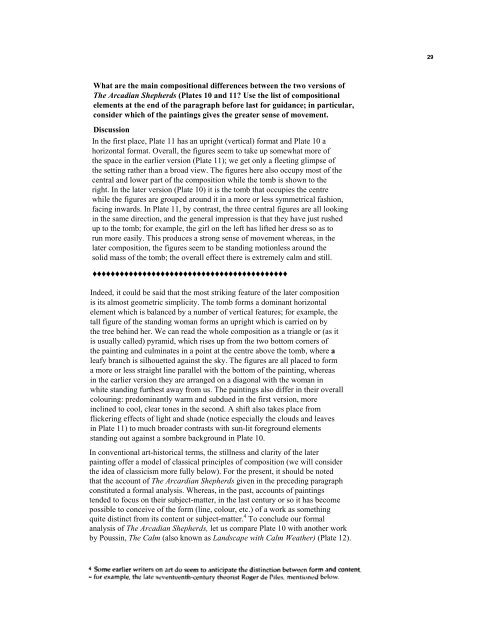The Arcadian Shepherds: a painting by Poussin
The Arcadian Shepherds: a painting by Poussin
The Arcadian Shepherds: a painting by Poussin
You also want an ePaper? Increase the reach of your titles
YUMPU automatically turns print PDFs into web optimized ePapers that Google loves.
What are the main compositional differences between the two versions of<br />
<strong>The</strong> <strong>Arcadian</strong> <strong>Shepherds</strong> (Plates 10 and 11? Use the list of compositional<br />
elements at the end of the paragraph before last for guidance; in particular,<br />
consider which of the <strong>painting</strong>s gives the greater sense of movement.<br />
Discussion<br />
In the first place, Plate 11 has an upright (vertical) format and Plate 10 a<br />
horizontal format. Overall, the figures seem to take up somewhat more of<br />
the space in the earlier version (Plate 11); we get only a fleeting glimpse of<br />
the setting rather than a broad view. <strong>The</strong> figures here also occupy most of the<br />
central and lower part of the composition while the tomb is shown to the<br />
right. In the later version (Plate 10) it is the tomb that occupies the centre<br />
while the figures are grouped around it in a more or less symmetrical fashion,<br />
facing inwards. In Plate 11, <strong>by</strong> contrast, the three central figures are all looking<br />
in the same direction, and the general impression is that they have just rushed<br />
up to the tomb; for example, the girl on the left has lifted her dress so as to<br />
run more easily. This produces a strong sense of movement whereas, in the<br />
later composition, the figures seem to be standing motionless around the<br />
solid mass of the tomb; the overall effect there is extremely calm and still.<br />
♦♦♦♦♦♦♦♦♦♦♦♦♦♦♦♦♦♦♦♦♦♦♦♦♦♦♦♦♦♦♦♦♦♦♦♦♦♦♦♦♦♦♦<br />
Indeed, it could be said that the most striking feature of the later composition<br />
is its almost geometric simplicity. <strong>The</strong> tomb forms a dominant horizontal<br />
element which is balanced <strong>by</strong> a number of vertical features; for example, the<br />
tall figure of the standing woman forms an upright which is carried on <strong>by</strong><br />
the tree behind her. We can read the whole composition as a triangle or (as it<br />
is usually called) pyramid, which rises up from the two bottom corners of<br />
the <strong>painting</strong> and culminates in a point at the centre above the tomb, where a<br />
leafy branch is silhouetted against the sky. <strong>The</strong> figures are all placed to form<br />
a more or less straight line parallel with the bottom of the <strong>painting</strong>, whereas<br />
in the earlier version they are arranged on a diagonal with the woman in<br />
white standing furthest away from us. <strong>The</strong> <strong>painting</strong>s also differ in their overall<br />
colouring: predominantly warm and subdued in the first version, more<br />
inclined to cool, clear tones in the second. A shift also takes place from<br />
flickering effects of light and shade (notice especially the clouds and leaves<br />
in Plate 11) to much broader contrasts with sun-lit foreground elements<br />
standing out against a sombre background in Plate 10.<br />
In conventional art-historical terms, the stillness and clarity of the later<br />
<strong>painting</strong> offer a model of classical principles of composition (we will consider<br />
the idea of classicism more fully below). For the present, it should be noted<br />
that the account of <strong>The</strong> Arcardian <strong>Shepherds</strong> given in the preceding paragraph<br />
constituted a formal analysis. Whereas, in the past, accounts of <strong>painting</strong>s<br />
tended to focus on their subject-matter, in the last century or so it has become<br />
possible to conceive of the form (line, colour, etc.) of a work as something<br />
quite distinct from its content or subject-matter. 4 To conclude our formal<br />
analysis of <strong>The</strong> <strong>Arcadian</strong> <strong>Shepherds</strong>, let us compare Plate 10 with another work<br />
<strong>by</strong> <strong>Poussin</strong>, <strong>The</strong> Calm (also known as Landscape with Calm Weather) (Plate 12).<br />
29

















